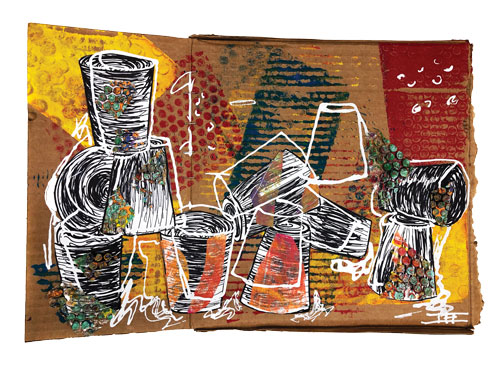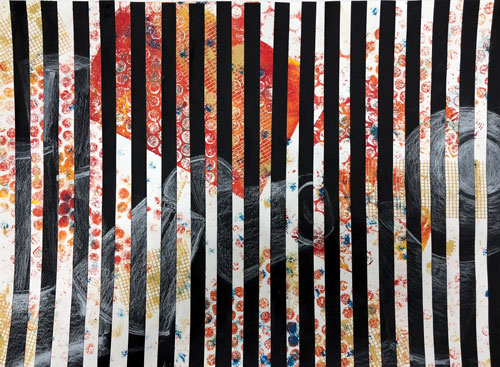 |
 |
 |
 |
| Top to bottom: Renee C., Ellie M., Isabella H., Savana T. |
Switching It Up
I prepared for this lesson by hot-gluing white cups into four separate still-life sculptures in challenging positions on mat board. My advanced students usually sit wherever they want, but for this assignment, I wanted them to get to know their classmates. I split the class into four different teams by having students count off in fours. This forced them to leave the comfort of their group of friends and sit with new peers.
Drawing from Still-Life Setups
I asked students to draw the still-life large and make an interesting composition, using most of the paper and varying line quality. I approved their rough drafts before they started work on their final papers. I also asked to see their drawing before they added cross-contour lines with pen or marker. Students drew from direct observation and tried to show the light source by using varied weights of lines. I encouraged them to curve their lines to follow the shapes of the cups so they would appear more three-dimensional. Once the drawings were complete, I asked students to take a good-quality photograph of their works before we spiced them up.
I challenge my students to set them apart from others. We’re not in class to make “pretty pictures,” but to develop a unique student voice for each of them. It’s nice if students make something beautiful, but I want them to take risks with their work and find out a little more about themselves in the process. It isn’t necessarily about the end product; it’s about the process.
Adding Surface Manipulation
Next, I encouraged students to add some emphasis to their pieces and play with surface manipulation. A few students added expressive lines in the negative spaces or added more cups overlapping their original drawing. Some students made neat textured prints and then tore them up to lay on top of their still life; some students printed right on top of their drawings and others chose to tear their pieces or even cut out their drawings and glue them on cardboard.
Students were excited to change things up and give their own voice to their still life. It was fun to watch them take risks and see that they were really pleased with their mixedmedia compositions.
A New Approach to the Same Subject
After these pieces were finished, I had students draw the same still life again, but this time with white charcoal pencil on black paper focusing on value, light, and shade. Students asked if they could “push” their second still-life drawing and those artworks were super successful as well, with some students fragmenting and slicing up their drawings.
Reflections
I’ve never seen such beautiful and original still-life pieces. Even if students don’t have the best technical skills, they can make an aesthetically pleasing composition by applying the elements of art and principles of design. They loved the flexibility and the risk-taking involved in this project, and they really enjoyed exploring various techniques and styles.
This is such a strong lesson because drawing from direct observation improves technical skills immensely, and I find that students are more open to taking risks when they feel comfortable with various media. Students also can’t complain about boring still lifes because they take ownership of their works. No still life should ever be boring.
Kathleen Sneed Petka is a visual art teacher at Walton High School in Marietta, Georgia. kathleen.petka@cobbk12.org
NATIONAL STANDARD
Creating: Generate and conceptualize new artistic ideas and work.
WEB LINK
A Conversation with Kathleen Petka: bit.ly/KathleenPetkaInterview
View this article in the digital edition.





